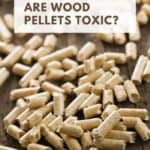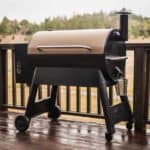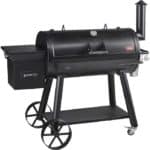All your wood pellet safety questions answered. Pellet chemical content and health information to help you keep safe while pellet cooking.

A common concern with all types of barbecue is if the fuel we’re using is toxic. With charcoal grilling it’s been the debate over the presence of carcinogens in the smoke; with propane it’s been the danger of inhalation; and with wood pellets it’s around if the fuel is dangerous.
Are BBQ wood pellets toxic? And if so, to what degree? Does the risk outweigh the reward? Let’s take a deep look in this article.

First a disclaimer. I am in no way a health expert, nor am I a scientist. I simply want to display all the facts that I am aware of, and outline them in a clear way so that you can make a sensible decision for yourself. I will link to everything that I have read around the subject, and be as transparent as possible.
How are BBQ Wood Pellets Made?
Wood pellets come in many forms and can be used for a lot of uses, but in the context of barbecue and for pellet smoker grills they are commonly made from compacted sawdust.
The wood – sometimes fresh and sometimes recycled – is processed through a hammer mill. The mill smashes the wood and beats it down until it forms a mix that isn’t too dissimilar to dough. This state makes it easier to manipulate the wood and to press it through pellet moulds.
The dough is processed through a press into holes that are about 6 millimeters in diameter. Think of this almost like a cheese grater.
While the wood goes through this stage, it’s also heated. This helps the pellets solidify, and also enables the natural binding agents within the wood to reactivate and form a natural glue to hold the pellets together once the wood cools again.
Once cooled, the pellets are cleaned and dusted down to remove any leftover sawdust. They are then packaged and distributed.

This process is a great way to make sure that each pellet is packed and densely as possible, so that it can provide as much heat and energy as possible when it comes to use.
The process also ensures that very little moisture is left in the wood. This ensures that each pellet can burn to its maximum potential without being dampened (literally) by any water content.
A dry, densely packed wood pellet ensures high energy, and maximum burn.
Are Wood Pellets Toxic?
When pellets are produced in line with the process above, there is little threat in terms of toxicity.
The production process is designed so that the wood pellets you use are produced as naturally as possible, using only the original contents of the natural wood.
This method is employed by famous big name brands like Pit Boss and Traeger, so if you buy big brand then you have nothing to worry about.
If you buy cheaper pellets then there is a high chance that they use chemical binding agents or additives in their pellets to help lower production costs.
This isn’t exclusive to wood pellet production, and is also true for cheap charcoal and briquette production.
Find out the differences between pellet and charcoal grills
Whether they’re in the form of filler contents, or ‘enhancing’ flavors, the addition of chemicals runs of the risk of turning your pellets toxic, especially when they are then exposed to heat and burn up to emit chemicals.
I recommend avoiding these and always buying all natural wood pellets from trusted brands.
That isn’t to say that natural wood pellets don’t have their own dangers, though (source).
Beyond the obvious fire hazard that’s true for any heat fuel, emissions from your grill should be a key concern.
Just like with any wood, pellets emit carbon monoxide gas. Long exposure to this can be harmful, so always try to stand away from being directly in line with smoke emissions coming your way.
The good news is though that should you do this then you are not in any real danger. Significant carbon monoxide exposure would require standing in smoke, burning at high heat, for hours.










